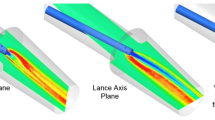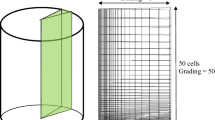Abstract
To solve the lack of reduced Blast furnace gas (BFG) mechanism under elevated pressure environment in numerical simulation, the present paper analyzes the sensitivity of every elementary reaction to combustion rate by using one dimensional laminar premixed reactor model. The steps with sensitivities larger than 0.1 are selected and the chemical kinetic parameters are revised by the method of weighted least squares fitting. The reduced 18-step mechanism which is specified to 0.1-3 Mpa is validated for laminar flame speeds, ignition delay times with available experiment data and GRI3.0 mechanism. Moreover, both the reduced and DRM-22 mechanisms are introduced into an experimental burner and an industrial gas turbine combustor simulation. The results of temperature and main species distribution illustrate that the 18-step mechanism is able to give a reasonable prediction combustion simulation. The 18-step mechanism lays the foundation of further studying the combustion of the low calorific value fuels at high pressure conditions.
Similar content being viewed by others
References
P. S. Gregory and D. M. Frenklach, Chemical Mechanism for Natural Gas Combustion.
S. V. Subith and K. R. Hanson, Shock tube study of syngas ignition in rich CO2 mixtures and determination of the rate of H+O2+CO2?HO2+CO2, Energy and Fuels, 157 (2010) 990–997.
R. B. Wang, Reduced kinetic mechanisms and their numerical treatment I: Wet CO flames, Combustion and Flame, 94 (3) (1993) 271–294.
E. Petersen, M. D. Barrett and B. Alexander, New syngas/air ignition data at lower temperature and elevated pressure and comparison to current kinetics models, Combustion and Flame, 149 (1-2) (2007) 244–247.
M. P. D. Burke, L. Frederick and J. Yiguang, Assessment of kinetic modeling for lean H2/CH4/O2/diluent flames at high pressures, Proceedings of the Combustion Institute, 33 (1) (2011) 905–912.
A. F. Frassoldati and T. E. Ranzi, The ignition, combustion and flame structure of carbon monoxide/hydrogen mixtures. Note 1: Detailed kinetic modeling of syngas combustion also in presence of nitrogen compounds, International Journal of Hydrogen Energy, 32 (15) (2007) 3471–3485.
S. Priyank, Testing a small detailed chemical kinetic mechanism for the combustion of hydrogen and carbon monoxide, Combustion and Flame, 145 (1) (2006) 316–323.
L. Hui, Analysis of sensitivity to BFG combustion, Journal of Northeastern University:Nature Science Edition, 31 (12) (2010) 1745–1748.
S. G. Davis and H. Wand, An optimized kinetic model of H2/CO combustion, Proceedings of the Combustion Institute, 30 (1) (2005) 1283–1292.
T. Lu and C. K. Law, A criterion based on computational singular perturbation for the identification of quasi steadystate species: a reduced mechanism for methane oxidation with no chemistry, Combustion & Flame, 154 (4) (2008) 761–774.
T. Turányi, Applications of sensitivity analysis to combustion chemistry, Reliability Engineering & System Safety, 57 (1) (1997) 41–48.
J. Warnatz, Combustion Chemistry, Gardiner, W. C. (Ed.), John Wiley, New York, 232 (1984).
H. Jinli and C. Guobiao, Reduced mechanism for oxygen/methane combustion based on sensitivity analysis, Journal of Aerospace Power, 27 (7) (2012) 114–119.
R. K. Miller, CHEMKIN-II: A Fortran chemical kinetics package for the analysis of gas-phase chemical kinetics, Sandia Report (1989).
D. M. Morett, A reduced chemical kinetic mechanism for computational fluid dynamics simulations of high brake mean effective pressure, lean-burn natural gas engines, Colorado State University (2012).
G. P. Smith, Chemical mechanism for natural gas combustion.
L. Juan and A. Kazakov, A comprehensive kinetic mechanism for CO, CH2O, and CH3OH combustion, Interntional Journal of Chemical Kinetics, 39 (3) (2007) 109–136.
D. L. Baulch and R. A. Cox, Evaluated kinetic data for combustion modeling, J. Phys. Chem, Ref. Data, 21 (1994).
R. J. Kee and F. M. Meeks, Chemkin-III: A Fortran chemical kinetics package for the analysis of gas-phase chemical and plasma kinetics, Office of Scientific & Technical Information Technical Reports, Sand 96 (1996).
D. Pugh, Combustion characterization of compositionally dynamic steelworks gases, Thesis, Cardiff University, UK (2013).
Z. M. Nikolaou, J. Y. Chen and N. Swaminathan, A 5-step reduced mechanism for combustion of CO/H2/H2O/CH4/CO2 mixtures with low hydrogen/methane and high H2O content, Combustion and Flame, 160 (1) (2013) 56–76.
L. D. Thi, Y. Zhang, J. Fu and Z. Huang, Study on ignition delay of multi-component syngas using shock tube, Can. J. Chem. Eng., 92 (5) (2014) 861–870.
M. Hossain and W. Malalasekera, A combustion model sensitivity study for CH4/H2 bluff-body stabilized flame, Proceedings of the Institution of Mechanical Engineers Part C. Journal of Mechanical Engineering Science, 221 (11) (2007) 1377–1390.
A. Kazakov and M. Frenklach, Reduced reaction sets based on GRI-Mech 1.2, University of California at Berkeley, USA (1994).
Author information
Authors and Affiliations
Corresponding author
Additional information
Recommended by Associate Editor Jeong Park
Zhao Yang received his Bachelor degree from Xi’an Jiaotong University on Energy and Power Engineering. He is now a Master-Doctor combined program graduate student in Xi’an Jiaotong University. His research interests are on Emissions, combustion dynamics and mechanism reduction.
Xiangsheng Li is a Lecturer from Xi’an Jiaotong University. His research interests include fluid dynamics, heat transfer and combustion in power equipment, emissions and control of gas turbine combustor, optimization techniques for combustor design and fuel flexibility.
Rights and permissions
About this article
Cite this article
Yang, Z., Li, X., Feng, Z. et al. Sensitivity analysis and chemical reaction mechanism simplification of blast furnace gas in gas turbine combustor environment. J Mech Sci Technol 31, 2005–2014 (2017). https://doi.org/10.1007/s12206-017-0350-7
Received:
Revised:
Accepted:
Published:
Issue Date:
DOI: https://doi.org/10.1007/s12206-017-0350-7




